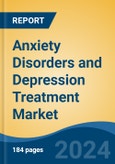Antidepressant Drugs is the fastest growing segment, North America is the largest market globally
Speak directly to the analyst to clarify any post sales queries you may have.
10% Free customizationThis report comes with 10% free customization, enabling you to add data that meets your specific business needs.
Key Market Drivers
The Global Anxiety Disorders and Depression Treatment Market is significantly influenced by the escalating worldwide incidence of mental health conditions and ongoing innovations in therapeutic strategies. The rising global prevalence of anxiety and depression disorders directly expands the addressable patient population requiring interventions, thereby acting as a fundamental growth catalyst for the market. This demographic shift necessitates broader access to diagnostic tools and diverse treatment options.Key Market Challenges
The substantial economic burden linked to developing and delivering novel therapeutic solutions directly impedes the growth of the Global Anxiety Disorders and Depression Treatment Market. The extensive research and development phases for new antidepressants, anxiolytics, and advanced neurostimulation techniques necessitate considerable financial investment. These high costs ultimately translate into elevated pricing for new treatments, making them less accessible, particularly in regions with limited healthcare budgets and less developed infrastructure.Key Market Trends
The expansion of digital therapeutics and telehealth solutions significantly influences the anxiety disorders and depression treatment market by enhancing accessibility and scalability of care. These platforms leverage technology to deliver evidence-based interventions remotely, reaching a broader patient population, particularly in underserved areas. According to GSMA's Mobile Economy 2024 report, approximately 5.6 billion people worldwide were mobile service subscribers in 2023, providing a vast infrastructure for these digital health services.Key Market Players Profiled:
- Abbvie Inc.
- Bristol-Myers Squibb Company
- Eli Lily & Co
- GlaxoSmithKline Plc
- H. Lundbeck A/S
- Johnson & Johnson Services, Inc.
- Merck & Co. Inc
- Pfizer Inc
- Sanofi
- Axsome Therapeutics Inc
Report Scope:
In this report, the Global Anxiety Disorders and Depression Treatment Market has been segmented into the following categories:By Product:
- Antidepressant Drugs
- Therapy and Devices
- Others
By Indication:
- Obsessive-Compulsive Disorder
- Major Depressive Disorder
- Phobia
- Others
By Region:
- North America
- Europe
- Asia Pacific
- South America
- Middle East & Africa
Competitive Landscape
Company Profiles: Detailed analysis of the major companies present in the Global Anxiety Disorders and Depression Treatment Market.Available Customizations:
With the given market data, the publisher offers customizations according to a company's specific needs. The following customization options are available for the report:- Detailed analysis and profiling of additional market players (up to five).
This product will be delivered within 1-3 business days.
Table of Contents
Companies Mentioned
- Abbvie Inc.
- Bristol-Myers Squibb Company
- Eli Lily & Co
- GlaxoSmithKline Plc
- H. Lundbeck A/S
- Johnson & Johnson Services, Inc.
- Merck & Co. Inc
- Pfizer Inc
- Sanofi
- Axsome Therapeutics Inc
Table Information
| Report Attribute | Details |
|---|---|
| No. of Pages | 183 |
| Published | November 2025 |
| Forecast Period | 2024 - 2030 |
| Estimated Market Value ( USD | $ 11.27 Billion |
| Forecasted Market Value ( USD | $ 15.92 Billion |
| Compound Annual Growth Rate | 5.9% |
| Regions Covered | Global |
| No. of Companies Mentioned | 10 |









